Hitchcock’s 9 Best “Talkie” Scenes
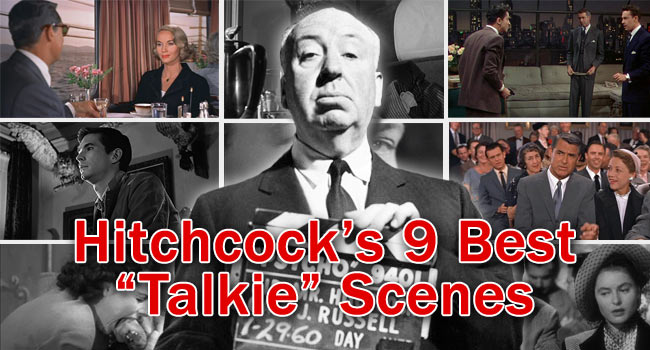
From June 14-16 at San Francisco’s wonderful Castro Theatre, the San Francisco Silent Film Festival will host the “Hitchcock 9”, a series of films from Hitchcock’s early days as a director in the silent era. The films have been beautifully restored and will be projected on the big screen with live music accompaniment by the acclaimed Mont Alto Motion Pcture Orchestra, Stephen Horne, and others.
Arguably the greatest director to make a movie, Alfred Hitchcock was a product of the silent film era, which he revered. Greats like Murnau, Dreyer, and Chaplin were masters at visual storytelling, and as far as Hitchcock was concerned, this was the medium at its pinnacle. When silent films were elbowed out by the “talkies”, Hitchcock was crushed, as the advent of sound compelled directors to demote visual storytelling below the novelty of the spoken word. Hitchcock referred to this new style of cinema as “filmed theater”, as these films had lost all visual technique and appeal.
Hitchcock, however, retained the sensibilities and discipline he learned from silent film, and applied them to all his work going forward. The nine films included in this festival are paramount to understanding what makes Hitch—and all movies, for that matter—tick.
In the spirit of the festival (and the reason we chose nine), we’re going to explore Hitchcock’s work with a couple of fun lists. We’re going to work backwards, starting here with our list of Hitchcock’s 9 Best “Talkie” Scenes, taking a look at scenes where he demonstrates he isn’t a snob and can shoot dialog as well! Next, we’ll take a look at Hitchcock’s 9 Best “Silent” Scenes, in which he employs and builds on the tools he developed in the silents. These two lists only include films after the silent era. Finally, we’ll hit you with our coverage of this weekend’s Hitchcock 9.
Though Hitchcock held visual storytelling above everything and often treated actors (who he believed must be treated like cattle) and their performances as simply another filmmaking component—like sound or set design—he certainly let them shine when he thought it appropriate. These are our nine favorite scenes where Hitchcock embraced his actors’ gabbiness.
9 Best “Talkie” Scenes from Alfred Hitchcock
#9 — The Lady Vanishes (1938) — Zany Train
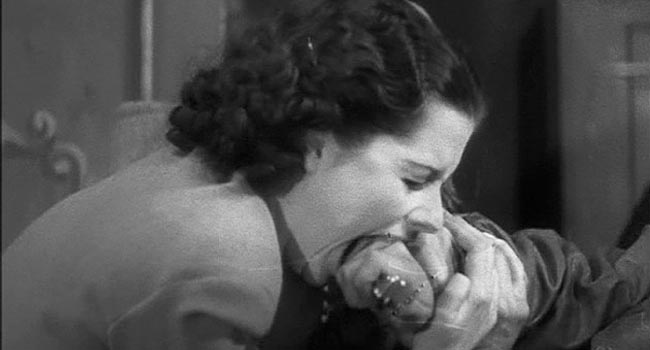
Hitchcock was a definite sucker for silly physical comedy (see the Frenzy truck scene, Family Plot runaway car scene). This scene, though not as talky as others on the list, stands out because the dialog is funny as hell and makes the scene better. Michael Redgrave and Margaret Lockwood are engaged in a hilariously choreographed “fight scene” over a pair of spectacles with a bulbous magician. They’re in a train car surrounded by an assortment of the magician’s things, like bunnies in a hat, birds, magic chests, and (funniest part) a life-sized cutout of the magician himself. As the two men scuffle on the ground, Lockwood worriedly bounces around them. “Don’t stand hopping about like a referee! Kick him! See if he’s got a false bottom!” commands Redgrave. The magician (naturally) escapes through the false bottom of his magic chest.
Favorite Quote: “Naughty naughty! That’s a very large nose for a very large pair of spectacles!”
Watch “Zany Train” scene: (skip to 7:45)
#8 — The 39 Steps (1935) — Hannay’s Babble
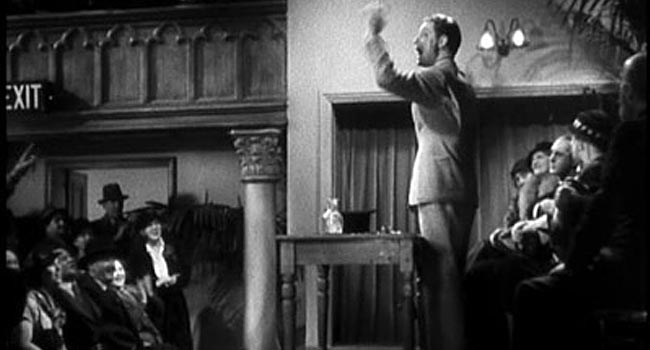
The 39 Steps has many scenes that blossom into better versions in it’s spiritual successor, North by Northwest, but its public speaking scene (echoed in NXNW by the auction scene) is still very good. Hannay (Robert Donat), on the run from a pack of pursuers, ducks into a random door off the street and is mistaken for a politician who is expected to make a speech at a political rally within moments. He takes this as an opportunity to, at least momentarily, evade the bad guys. Hannay takes the podium and uses his gift for gab and quick wit to dance around his complete ignorance of the issues of the evening. He addresses the congregation: “We’re going to discuss some topic. What shall it be?” A concerned citizen answers, “The idle rich!” to which Hannay cleverly responds, “That’s a bit of an old topic these days, especially for me, because I’m not rich and I’ve never been idle!” A master bullshitter.
Favorite Quote: “MacCrocodile.”
Watch “Hannay’s Babble” scene:
#7 — Strangers on a Train (1951) — I’ll Scratch Your Back…
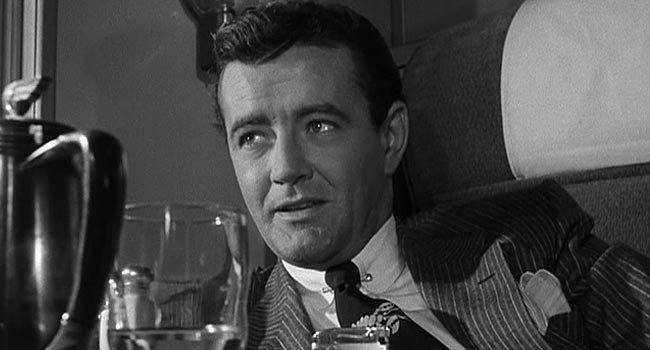
Hitchcock has always been known to repeat himself in his works (the airplane scenes in North by Northwest and The 39 Steps, countless staircase scenes), and one of the most revisited scenes by the master is the oddly casual and detailed outlining of a hypothetical (?) murder. Perhaps the most eminent is this one, from the brilliant Strangers on a Train. “Wanna hear my idea for a perfect murder?” Robert Walker is as brazen as a child as he submits his macabre scenarios to the apprehensively dismissive Farley Granger, the other titular “stranger”. Walker relishes in his morbid fantasy while we identify (hopefully) with the more humane Granger, who is frightened by Walker’s enthusiasm.
Favorite Quote: “Your wife, my father. Criss-cross!”
Watch “I’ll Scratch Your Back…” scene:
#6 — North by Northwest (1959) — Auction Audible
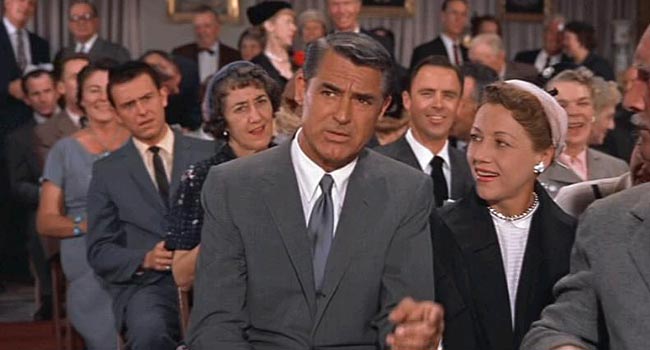
Cary Grant, as the cosmopolitan wrong-man Roger O. Thornhill, is trapped at a bustling fine art auction, with goons blocking every exit. Out of options, his clever solution is to create mayhem. Hysterically, he begins making nonsensical bids on the valuable pieces: “13 dollars! That’s more than it’s worth!” The crowd begins to vibrate with annoyance, and Grant churns the chaos further: “How do we know it’s not a fake? It looks like a fake!”To which an irritated woman snips, “You’re no fake. You’re a genuine idiot!” “Thank you” replies Grant, pleased with his ingenuity. He hilariously knocks out a security guard, earning him a police escort out of the building. Cary Grant could do anything, and this is one of his finest and most endearing comedic performances.
Favorite Quote: “What took you so long?”—Grant, to the police officers.”
Watch “Auction Audible” scene:
#5 — Rope (1948) — Cat and Mouse

Rupert (James Stewart), in a state of shock, almost pleads with Brandon (John Dall): “Did you think you were God, Brandon? Is that what you thought when you served food from his grave!?” Brandon and Phillip (Farley Granger) have just hosted a party with the centerpiece being a chest containing their dead friend David (who they’ve freshly strangled). Strangely, they did it for the thrill, and they would have gotten away with it had it not been for their final party guest, the uber-intelligent Stewart. Granger’s neurotic paranoia explodes as Stewart begins to Sherlock their little scheme. “Cat and mouse, cat and mouse! But which is the cat and which is the mouse…” growls Granger. Stewart and Dall’s tug-of-war about the morality of a “superior race” is fascinating and was hotly relevant at the time. Stewart gets to show big emotion here, which fits nicely with Rope’s theater-esque presentation.
Favorite Quote: “If nothing else, a man should stand by his words, but you’ve given my words a meaning I’ve never dreamed of!”
Watch “Cat and Mouse” scene:
#4 — Shadow of a Doubt (1943) — Did He Just Say That?
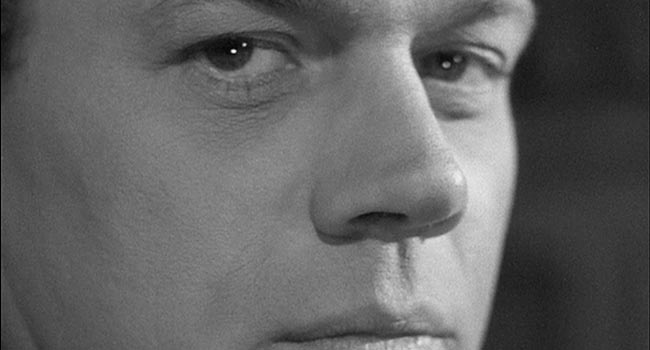
When Uncle Charlie (played by Joseph Cotton, gifted with a classically evil face) sits with his sister’s family for a quaint, suburban, All-American dinner, he shatters the cheerful mood with a spit-take-worthy misogynistic tirade. We slowly zoom in on him as he pompously describes widows as “silly…useless…faded, fat, greedy women.” His good-hearted niece (Teresa Wright) defends the widows: “They’re alive! They’re human beings!” Cotton then, in a masterstroke by Hitchcock, looks straight at the camera and replies, “Are they?” Positively rattling. Uncle Charlie is one of the baddest baddies in Hitchcock’s oeuvre, and this is his moment. You can almost hear hundreds of moviegoers in 1943 collectively screaming “BOOOOOOOO!!!”
Favorite Quote: The whole dirty, rotten thing
Watch “Did He Just Say That?” scene:
#3 — Notorious (1946) — Heartbreak at the Races
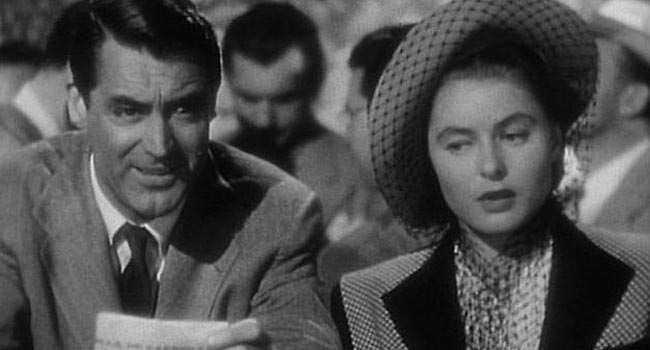
An electric scene from my favorite Hitchcock film. Alicia Huberman (Ingrid Bergman), an American daughter of a Nazi spy, has fallen for US government agent T.R. Devlin (Cary Grant), who is forced by his superiors to instruct her to seduce Alex Sebastian, one of her father’s old friends in order to obtain the [MacGuffin!]. They’re conflicted about the assignment, yet are too passive and stubborn to blow the mission and reveal their true feelings for one another, frustrating the both of them. In a (public) secret meeting at a crowded horse race, Bergman reports to Grant on her progress: “You can add Sebastian’s name to my list of playmates.” Grant viciously assures Bergman that her “loose” behavior doesn’t surprise him: “You almost had me believing…that a woman like you could…change her spots.” Bergman is heartbreaking as she hides her wet eyes behind her binoculars. Grant fights not to flinch as he suppresses his love.
Favorite Quote: “Dry your eyes, baby. It’s out of character.”
Watch “Heartbreak at the Races” scene: (skip to 8:10 for the scene)
#2 — Psycho (1960) — Dinner With Norman
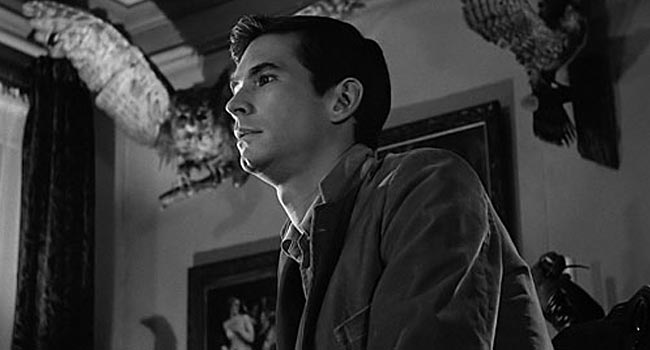
Birds are a major motif in Psycho. In the most loquacious of the film’s numerous iconic scenes, our protagonist—Marion Crane from Phoenix—shares an unsettling dinner of sandwiches and milk in the Bates Motel back office with the schizoid mama’s boy Norman. The dynamic between Janet Leigh and Anthony Perkins is as nimble as the stuffed birds on the walls once were, jumping from friendly to aggressive to empathetic to frightening, all seamlessly. Like magic, these two just click, giving performances of a lifetime. Hitchcock was often (unjustly) accused of mistreating his actors, but here he gives them his uninhibited trust. The funny thing is, despite these characters’ fates, they make a fleeting connection: “You’ve never had an empty moment in your whole life, have you?” says Perkins. Somberly, Leigh replies, “Only my share.”
Favorite Quote: “People always mean well. They cluck their thick tongues and shake their heads and suggest oh so very delicately…”
Watch “Dinner With Norman” scene:
#1 — North by Northwest (1959) — Sex on a Train
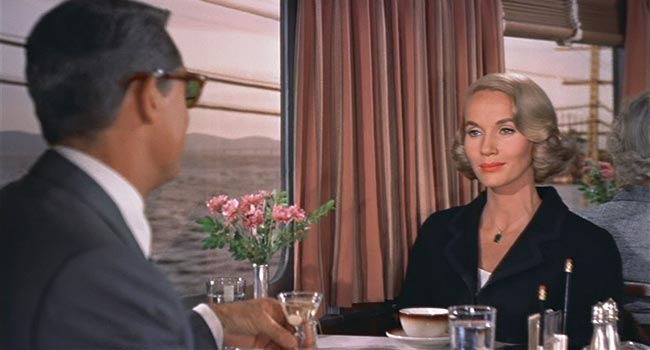
Eva Marie Saint is sex and seduction in the flesh sitting across from Cary Grant on the train in North by Northwest. This is one of the most suggestive, sexually charged scenes of dialog ever, especially considering the time period it belongs to. Marie Saint is thrilling in her bluntness: “It’s going to be a long night, and I don’t particularly like the book I’ve started. You know what I mean?” “Yes, I know exactly what you mean” replies Grant, who is as in awe of her lustiness as we are. When she gently puckers her lips to blow out a lit match in Grant’s fingers, it’s time to put the kiddies to bed. These are two of the most attractive movie stars ever virtually eye-fucking each other. Hitchcock believed that sex scenes should have an element of suspense to them, and by the end of this one we’re so worked up we could explode.
Favorite Quote: “Luck had nothing to do with it.”
Watch “Sex on a Train” scene:
